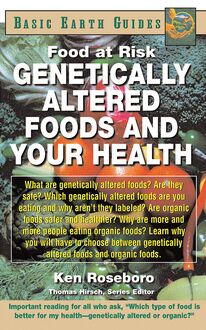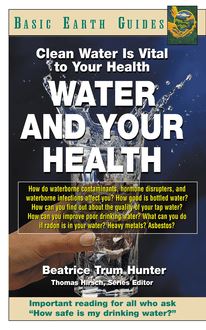Water and Your Health , livre ebook
56
pages
English
Ebooks
2003
Vous pourrez modifier la taille du texte de cet ouvrage
Obtenez un accès à la bibliothèque pour le consulter en ligne En savoir plus
Découvre YouScribe en t'inscrivant gratuitement
Découvre YouScribe en t'inscrivant gratuitement
56
pages
English
Ebooks
2003
Vous pourrez modifier la taille du texte de cet ouvrage
Obtenez un accès à la bibliothèque pour le consulter en ligne En savoir plus
Publié par
Date de parution
01 janvier 2003
Nombre de lectures
0
EAN13
9781591206149
Langue
English
Poids de l'ouvrage
2 Mo
Publié par
Date de parution
01 janvier 2003
Nombre de lectures
0
EAN13
9781591206149
Langue
English
Poids de l'ouvrage
2 Mo
The information contained in this book is based upon the research and personal and professional experiences of the author. It is not intended as a substitute for consulting with your physician or other healthcare provider. Any attempt to diagnose and treat an illness should be done under the direction of a healthcare professional.
The publisher does not advocate the use of any particular healthcare protocol but believes the information in this book should be available to the public. The publisher and author are not responsible for any adverse effects or consequences resulting from the use of the suggestions, preparations, or procedures discussed in this book. Should the reader have any questions concerning the appropriateness of any procedures or preparations mentioned, the author and the publisher strongly suggest consulting a professional healthcare advisor.
Series Editor: Thomas Hirsch • Typesetter: Gary A. Rosenberg Series Cover Designer: Mike Stromberg
Basic Health Publications, Inc.
8200 Boulevard East • North Bergen, NJ 07047 • 1-800-575-8890
Library of Congress Cataloging-in-Publication Data
Hunter, Beatrice Trum.
Water and your health : clean water is vital to your health / by Beatrice Trum Hunter.
p. ; cm. —(A basic earth guide)
Includes bibliographical references and index.
ISBN 1-59120-039-3
ISBN-13: 978-1-59120-614-9
1. Drinking water—Health aspects—Popular works.
[DNLM: 1. Water Supply—Popular Works. 2. Water
Microbiology—Popular Works. 3. Water Pollutants—Popular Works. 4. Water Pollution—Popular Works. 5. Water Purification—Popular Works.
WA 675 H945w 2003] I. Title. II. Series.
RA591.H86 2003
613.2'87—dc21
2003002007
Copyright © 2003 by Beatrice Trum Hunter
All rights reserved. No part of this publication may be reproduced, stored in a retrieval system, or transmitted, in any form or by any means, electronic, mechanical, photocopying, recording, or otherwise, without the prior written consent of the copyright owner.
Printed in the United States of America 10 9 8 7 6 5 4 3 2 1
C ONTENTS
Editor’s Note
Introduction: Water and Your Health
1. The Natural Resource You Can’t Live Without
2. The Nation’s Water: Regulating Safety
3. Drinking Water:What Gets into It?
4. Waterborne Epidemics
5. Waterborne Infections
6. Water from Your Tap: Soft or Hard?
7. Water Filters: Which One Is Best?
8. Bottled Waters: What Is in Them?
9. Water Humidifiers and Misters: Keep Them Clean,
10. Conserving Water: Make Every Drop Count
References
Bibliography for Further Reading
About the Author
E DITOR’S N OTE
Welcome to the Basic Earth Guide series! As you know, the natural world is becoming degraded at an alarming rate. Hardly a day passes without a new headline about the effects of global warming, species loss, and other distressing environmental news. Incredibly, during every second of every day, more than an acre of the world’s precious and irreplaceable rain forests is being lost. The depletion of beneficial oxygen-producing plants, which are part of the rain forest’s ecosystem, makes us vulnerable to the 6,000 metric tons of carbon dioxide emitted into the atmosphere each year. The subtraction of oxygen, and the addition of carbon dioxide, adversely affects everyone’s health and quality of life.
This example is but one of a number of environmental problems that beset us. Residues of toxic pollutants, ranging from pesticides in our food; chemicals in our homes such as cleaning agents, sealants, solvents, formaldehyde, and lead-contaminated paint; gas leakages from cookstoves; outgassings from plastics; fragrances in consumer products; to a host of other volatile substances, both indoors and outdoors, affect our health. Over time, chronic exposures to these substances compromise our immune systems and contribute to various illnesses and health problems.
Some experts caution that we have only one generation of time to reverse conditions in our polluted environment, or we shall experience irreversible damage. Many people feel that the problems are on such a vast scale, are so complex and overwhelming, that individual efforts are futile. They are wrong.
The Basic Earth Guide series demonstrates that you, as an individual, can take meaningful action. Each Earth Guide sets forth a group of ecological problems that you face daily and provides alternative, environmentally sound practical solutions. Each Guide provides the best-researched ideas and most up-to-date information to help you transform your day-to-day living into an ecologically sounder environment. The works are written simply and lucidly for easy comprehension. Among topics covered are renewable energy, “green” building and retrofitting, home care and maintenance, personal-care products, and ecological lifestyles.
As a reader of Basic Earth Guides, you will become better informed and motivated to improve the environmental quality of your life, as well as the lives of those around you. There can be a new world out there! We thank you for allowing us to introduce it to you.
Green regards,
Thomas Hirsch, series editor
P.S. Do let us know about additional subjects that interest you, for us to consider as future Basic Earth Guides. You can reach us at: ngoldfind@basichealthpub.com .
W ATER AND Y OUR H EALTH
W
ater is an essential nutrient for every human being. The body is two-thirds water; the Earth’s surface is three-fourths water. Water cleanses our bodies; water cleanses the Earth. Water transports nutrients to the cells and removes waste products from the body; water is used in the products we make. Yet increasingly the wastes from these products, and often the products themselves, are spewed into rivers, lakes, and oceans. Are we drinking water that we ourselves have polluted, but that we need to be clean and fresh in order for us to thrive?
Most contaminants in our water supply are invisible to the naked eye. The allowable parts per billion (ppb) seem so minuscule that we may not think anything is wrong with our drinking water. We may not think the quality of water in another country, on another continent, affects ours. Yet it does. Water contaminants, such as heavy metals, carcinogens, and pharmaceutical and agricultural runoffs, are accumulating in our bodies and wearing down our defenses.
How to prevent contamination, so that the clean water we use is recycled as quality water, is a formidable task. Water and Your Health presents the problem concisely and offers practical information about how we can solve the problem. The more enlightened we are about our water uses in homes, in industries, and in nature, the better we will be equipped to prevent water contamination and to have access to clean water.
T HE N ATURAL R ESOURCE Y OU C AN’T L IVE W ITHOUT
T
he Food and Drug Administration (FDA) regards water as a nutrient, and rightly so. Water is a vital nutrient that sustains the body. The body can survive without food for a longer time than without water.
Repeatedly, we are told that the average adult should drink at least eight glasses of water daily. Yet many people ignore this advice, drinking only when they feel thirsty. Thirst, however, is not a reliable indicator. By the time the body signals thirst, dehydration has already begun. Inadequate water intake is all too common, and chronic dehydration carries many health risks.
For people living in warm climates, adequate water replenishment is especially important. The Israeli nutritional graphic of a chalice, equivalent to our nutritional graphic of a pyramid, displays the nutritional foods basic to health. Water is placed at the very top of the chalice, emphasizing its utmost importance. In a recently devised American nutritional pyramid for people age seventy years and older, eight glasses of water are at the base of the pyramid. Thus, new emphasis is given to old advice.
Adequate water is essential throughout the body. Tissues need water. About 60 percent of the water in the body appears inside the cells of every type of body tissue: blood, bone, muscle, and fat. The remainder is in the cells of the gastrointestinal tract, eyes, spinal column, and joints (such as knees and elbows).
The body uses water in many ways. Water dissolves many chemical compounds so that the body can utilize them. Water serves as a medium in which chemical reactions constantly occur. The fluid in blood transports glucose to working muscles, and carries away byproducts. Fluid in the urine helps eliminate metabolic wastes from the body.
In aging, the thirst mechanism—as well as other senses—may decline. If water intake is inadequate, the blood thickens and reduces circulation, which makes the brain more susceptible to senility.
A study of active elderly men, sixty-seven to seventy-five years of age, deprived of water for twenty-four hours, found that they were less thirsty and drank less water than younger, active adult men. For this reason, it is especially important for the elderly to develop a habit of drinking water frequently, even if their bodies are not signaling thirst. Because of the problem of incontinence, many elderly people purposely avoid fluid intake before social activities or prior to bedtime. Such avoidance may lessen inconvenience, but can contribute to chronic dehydration and health problems.
As noted, by the time a person experiences a thirst signal, the body already has become partially dehydrated, and as much as 3 percent of the body’s weight may have been lost in water. The elderly and children are groups at highest risk of dehydration. Both groups are apt to be somewhat insensitive to thirst signals.
With inadequate water intake, the body slows down. This happens in the dead of winter as well as during the sweltering hot summertime. Signs of inadequate water intake may include a general sense of malaise, fatigue, lassitude, dizziness, and irritability. Signs of extreme dehydration may include hea

